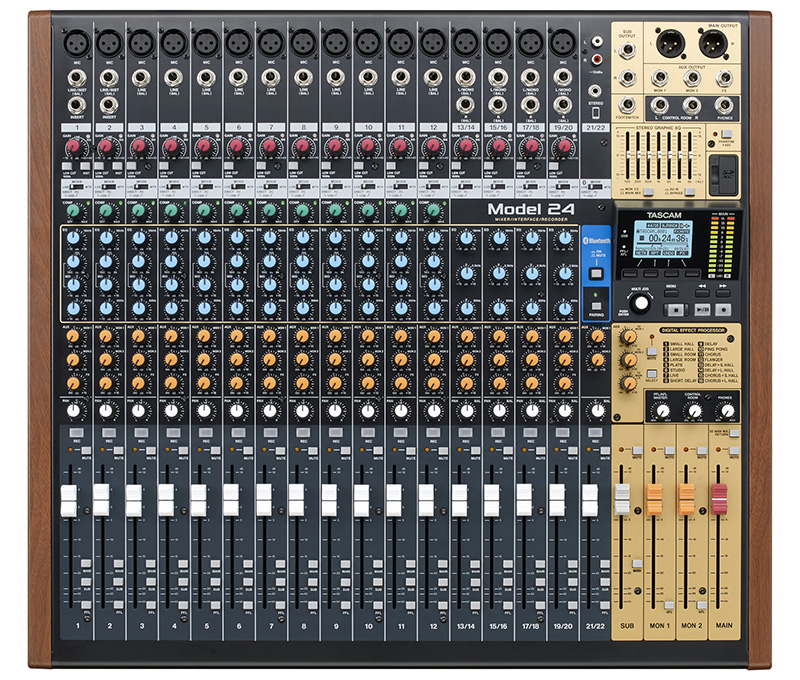
Image retrieved from Tascam's Website
The Tascam Model 24 is a 20 input sound mixer with 24 digital outputs.
Multi-Channel, Stereo, or Mono Recording?
When recording, you will need to choose if you want to use multi-channel, stereo, or mono recording. This determines how many separate "tracks" (also known as "channels") or audio streams you will save during a recording session. Briefly:
- Mono records only one track so all input audio will be on the same track
- Stereo records two tracks which are generally referred to as "left" and "right". The panning knob on the soundboard can adjust the proportion of "left" and "right" for each input
- Multi-channel records the audio from each input on a separate track
For simple recordings where you don't intend to do audio post-processing, a mono or stereo recording is usually best as these are much easier to set-up. If you wish to have different sounds play out of different speakers (e.g., one input outputs only through a listener's left headphone and another only outputs through the right), this can be achieved with stereo recordings.
When you wish to perform post-processing, a multi-channel recording is usually best. This allows you to isolate operations like adjusting volume, removing noise, performing equalizations, etc. etc., to only a single audio source. For example, if you record a four-participant podcast where one presenter is much quieter than the other three, you can boost the volume for just that individual without affecting the volume of the other three presenters. Multi-channel recordings will usually get "mixed down" or exported to stereo audio files, so the added complexity is often not beneficial if you don't plan to do any editing or post-processing.
Multi-Channel Audio Recording in Audacity
- Plug the microphones desired into the wall-plate in the recording room or the free inputs on the soundboard
- Turn the soundboard power switch on
- Open Audacity
- Note, Audacity may prompt for software updates, but these can be safely ignored
- Set the audio protocol to WASAPI
- Set the "microphone" input to Model 24
- Set the number of channels to 24
- Set the output to the computer headphones (if you wish to monitor the audio)
With this setup, when you record, Audacity will automatically generate 24 tracks. The last two tracks are the overall stereo mix from the soundboard (all other inputs combined). Most of the generated tracks will likely be empty so, once you are done recording, you can safe select all of the empty tracks (click the first empty track then hold "shift" and click the last track) and use the "Tracks" menu to delete the selected tracks.
Multi-Channel Audio Recordings in Adobe Audition
- Plug the microphones desired into the wall-plate in the recording room or the free inputs on the soundboard
- Turn the soundboard power switch on
- Open Adobe Audition
- Use "Edit" > "Preferences" > "Hardware" to open the hardware settings panel
- Ensure the device type is set to WASAPI and the device is Model 24
- Create a new "Multi-track" recording
- For each track in the new recording window, set the input to the appropriate input channel from the soundboard (e.g., "1" is the first input on the soundboard)

